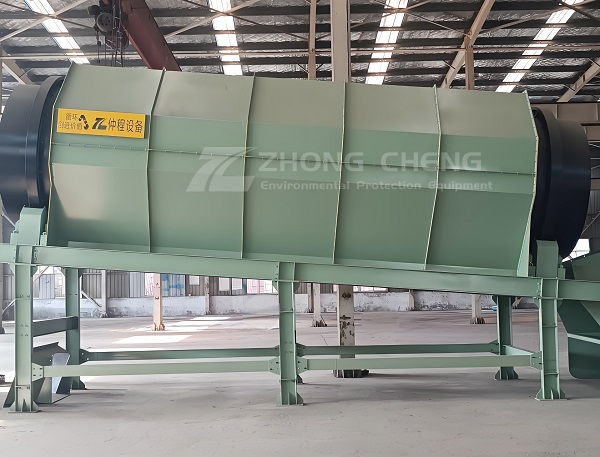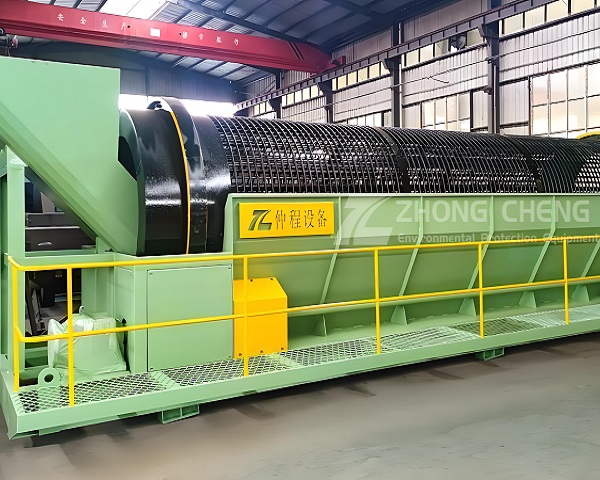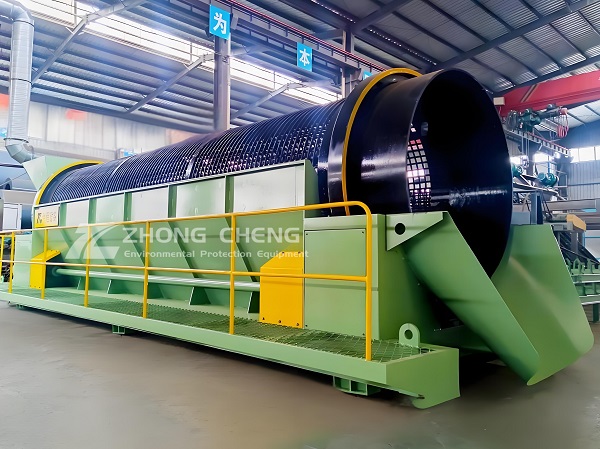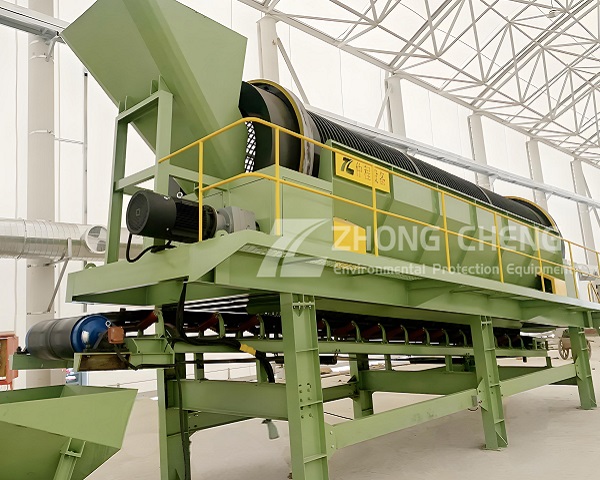In material grading processes across industries such as mining, building materials production, and environmental recycling, the rotary trommel screen, with its ingenious structure and strong adaptability, has become a key piece of equipment for achieving efficient screening. It overcomes the limitations of traditional screening equipment regarding material moisture and viscosity, balancing screening efficiency and grading accuracy through modular structural design and rotary screening principles. As industrial production increasingly demands more refined and environmentally friendly material grading, the technological value of the rotary trommel screen becomes increasingly prominent. This article will systematically dissect its structural design highlights and deeply analyze its core advantages, providing practical reference for industry users to optimize selection and improve production quality, thus helping related fields achieve efficient and low-carbon operation.

A. Core Structural Components and Design Features of the Rotary trommel screen As a highly efficient material grading device, the rotary trommel screen's structural design revolves around three core objectives: stable operation, accurate screening, and convenient maintenance. It mainly consists of the screen body, transmission system, support device, feeding device, discharging device, and auxiliary systems. These components work together to form a complete screening process.
1.Screen Body Structure: Core of Grading, Flexible Design

The screen body is the core working component of the trommel screen. It adopts a cylindrical structure, consisting of screen mesh, screen frame, and reinforcing ribs, connected to the drive shaft via a flange. The screen mesh material can be flexibly selected according to the characteristics of the material being screened. Common materials include carbon steel, stainless steel, and polyurethane: Carbon steel screen mesh is suitable for low-abrasive materials such as ordinary sand, gravel, and coal, and is cost-effective; stainless steel screen mesh has strong corrosion resistance and is suitable for industries such as chemical raw materials and food processing; polyurethane screen mesh has good elasticity and excellent wear resistance, with a service life 3-5 times that of ordinary metal screen mesh, suitable for high-strength abrasive materials such as granite and basalt.
The mesh aperture and arrangement can be customized, supporting single-layer or multi-layer screen combinations (up to 4 layers), enabling 1-5 grade grading. For example, in sand and gravel aggregate production, a three-layer trommel screen can separate materials of four sizes—0-5mm, 5-10mm, 10-20mm, and over 20mm—in one pass, significantly improving grading efficiency. The screen frame is welded from angle steel or channel steel with external reinforcing ribs to ensure the screen body does not deform during high-speed rotation, resulting in strong operational stability.
2. Transmission System: Stable Power, Optimized Energy Consumption

The trommel screen's transmission system mainly consists of a motor, reducer, coupling, and gear or belt drive. It adopts a "motor + reducer" drive mode, ensuring smooth power transmission and effectively reducing operating noise (typically below 75dB). Transmission methods include gear drive and belt drive: gear drive offers precise transmission ratios and high torque, suitable for large trommel screens (screen body diameter ≥ 2.5m) and high-load screening scenarios; belt drive has a simple structure, is easy to maintain, can buffer impact loads, reduce equipment wear, and is suitable for small and medium-sized trommel screens and screening brittle materials. To optimize energy consumption, the transmission system adopts a variable frequency speed control design. The motor power is matched according to the screen specifications and processing capacity, ranging from 3kW to 75kW. By adjusting the motor speed (usually 10-30r/min), it can adapt to the screening requirements of different materials: for viscous materials, reducing the speed prolongs the residence time of the material in the screen body, ensuring thorough screening; for materials with good flowability, increasing the speed improves processing efficiency, achieving a balance between energy saving and high efficiency.
3. Support Device: Reliable Bearing and Stable Operation
The support device consists of a roller assembly, a retaining wheel assembly, and a base, bearing the weight of the entire screen body. The roller assembly is forged from high-quality carbon steel or alloy steel, with a surface hardened to a hardness of HRC45-50, and is equipped with wear-resistant rubber bushings to reduce frictional wear with the screen body. The roller assemblies are usually symmetrically arranged in the middle of the screen body, with the number determined according to the length of the screen body (one set every 3-5m) to ensure uniform stress on the screen body.
The guide roller assembly is installed at the flanges at both ends of the screen body, acting as a limiter to prevent axial movement of the screen body during rotation and ensuring safe operation. The base is made of welded steel structure with shock-absorbing pads at the bottom to absorb vibrations generated during operation, reducing the impact on the ground and surrounding equipment. It also facilitates installation and commissioning without requiring complex foundation treatment.
4. Auxiliary System: Comprehensive Functions, Adaptable to Diverse Scenarios
The trommel screen is equipped with a comprehensive auxiliary system, including a cleaning device, a dust prevention device, and a lubrication system. The cleaning device uses a rotating scraper or brush installed on the inner wall of the screen body to remove clogging materials from the screen mesh in real time. It is especially suitable for screening sticky materials (such as fly ash and sludge) to prevent screen hole clogging and reduced screening efficiency. The dust prevention device uses a fully sealed cover design, completely enclosing the screen body, inlet, and outlet. Combined with a pulse dust collector, the dust emission concentration is below 10mg/m³, meeting environmental emission standards. The lubrication system employs a centralized oil supply method, periodically adding lubricating oil to rotating components such as rollers, retaining rollers, and bearings via an oil pump, reducing component wear and extending service life. Some high-end models are also equipped with an intelligent monitoring system that can monitor parameters such as bearing temperature, motor current, and screen vibration in real time, enabling fault early warning and remote diagnosis, thus reducing maintenance costs.
B. Core Advantages of the Rotary trommel screen

1. High Screening Efficiency and Accurate Grading: The rotary trommel screen uses a rotary screening principle. The screen body is installed at an inclined angle (usually 3°-8°). After the material enters from the feed inlet, it moves along the screen axis under the action of gravity and the centrifugal force of the rotating screen body, simultaneously completing grading. Compared to vibrating screens, the rotary trommel screen has a larger contact area between the material and the screen mesh, resulting in more thorough screening and higher grading accuracy (grading error ≤3%). For example, in the coal industry, the rotary trommel screen can accurately separate lump coal, fine coal, and coal gangue, with lump coal recovery rate increased by 10-15% compared to traditional screening equipment. Its processing capacity ranges widely, from 10t/h for small models to 1000t/h for large models, adapting to different production needs. Taking the Φ1800×6000 type trommel screen as an example, when processing medium-hard materials such as limestone, the hourly processing capacity can reach 200-300t, with a screening efficiency of over 90%, far exceeding that of vibrating screens of the same specifications.
2. Strong adaptability and wide applicability to materials. trommel screens can process various types of materials, including granular, powdery, and lumpy materials, as well as sticky, moist (moisture content ≤25%), and abrasive materials, making them suitable for multiple industries such as mining, building materials, coal, chemicals, and environmental protection. In the mining industry, it is used for pre-screening of metallic and non-metallic ores, separating waste rock in advance and reducing the load on subsequent crushing equipment. In the building materials industry, it is used for grading concrete aggregates and cement raw materials to improve product quality. In the environmental protection industry, it is used for construction waste recycling and sludge dewatering screening to achieve resource recycling.
Precise adaptation can be achieved by adjusting the screen material, aperture, rotation speed, and inclination angle to suit the characteristics of different materials. For example, when processing construction waste, polyurethane screens and a low-speed design are used to avoid damage to the screen from hard objects such as steel bars and bricks; when processing fine materials such as grains and fertilizers, stainless steel screens and a high-speed design are used to ensure screening accuracy and efficiency.
3. Stable operation and long service life. The trommel screen has a mature structural design, and its core components use high-strength materials and precision machining processes, resulting in strong operational stability and an average annual uptime of over 95%. The screen body adopts an integral welded structure, boasting high rigidity and outstanding vibration resistance, capable of withstanding impact loads from materials. Rotating components such as support rollers and thrust rollers are made of wear-resistant materials, coupled with a comprehensive lubrication system, ensuring a service life of 5-8 years. Motors, reducers, and other supporting equipment are sourced from well-known brands, ensuring high reliability and a low failure rate.
Furthermore, the equipment's vulnerable parts (such as screens and scrapers) feature a modular design, facilitating easy disassembly and replacement by a single person. Replacement time is reduced by more than 60% compared to traditional screening equipment, significantly minimizing maintenance downtime.
4. Convenient Operation and Maintenance, Low Overall Cost: The trommel screen's operation is simple, requiring no specialized skills; ordinary operators can master it after short-term training. The equipment employs an automated control design, enabling continuous operation of feeding, screening, and discharging. It supports remote control and unattended operation, reducing labor costs. In terms of maintenance, the equipment's rational structural layout and easy-to-maintain key components require only checking lubrication levels, cleaning screen blockages, and tightening connections, minimizing maintenance workload.
In terms of cost control, the initial investment cost of a rotary trommel screen is lower than that of a vibrating screen with the same processing capacity, and its operating energy consumption is low, with a unit energy consumption of only 0.5-1.2 kWh/t, saving about 40% energy compared to a vibrating screen. Taking a production line with an annual processing capacity of 500,000 tons as an example, it can save 200,000-300,000 yuan in electricity costs annually. At the same time, the procurement cost of vulnerable parts is low, their versatility is high, and market supply is sufficient, further reducing the overall operating cost.

5. Outstanding environmental performance, meeting policy requirements. The rotary trommel screen adopts a fully sealed structure design, combined with a pulse dust collector and vibration damping pads, which can effectively control dust and noise pollution, meeting environmental policy requirements. The advantages of the rotary trommel screen are particularly evident in scenarios with high environmental protection requirements, such as urban peripheries and ecologically sensitive areas. For example, in construction waste treatment plants, using a sealed rotary trommel screen with a dust removal system, the dust emission concentration can be controlled below 5 mg/m³, and the noise level is below 70 dB, without impacting the surrounding environment.
Furthermore, the equipment's energy-saving design complies with the "dual-carbon" policy requirements, boasting low unit energy consumption and high resource utilization, helping enterprises achieve green and low-carbon production and enhancing market competitiveness.
Based on a scientific structural design, the trommel screen exhibits significant advantages in screening efficiency, adaptability, and operational stability. Its flexible screen body design, stable transmission system, and comprehensive auxiliary devices ensure accurate grading and continuous operation; its adaptability to various materials, convenient operation and maintenance, and environmentally friendly and energy-saving characteristics significantly reduce overall operating costs. From mine pre-screening to environmental waste treatment, from building material aggregate grading to chemical raw material screening, the trommel screen provides efficient solutions. In the future, with upgrades in intelligent technology and materials, its adaptability and cost-effectiveness will be further improved, providing stronger equipment support for material grading in various industries and promoting high-quality development of the screening industry.
Save Time! Get A Detailed Quotation Quickly.
